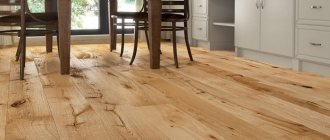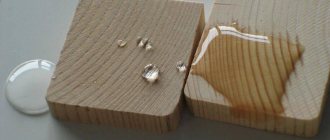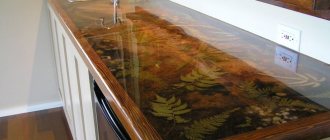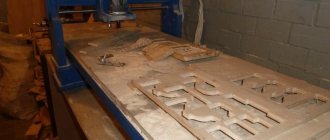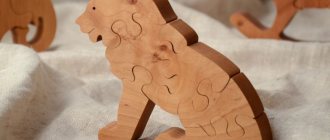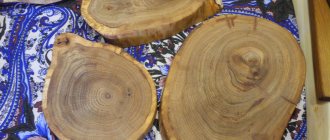Treating wood with oil is a traditional way of caring for wooden surfaces. Oil compositions ensure the safety of the material for many years of operation, impart hydrophobic properties to the surface and protect against the development of all kinds of unfavorable processes. However, oil treatment is not as simple an operation as it seems at first glance. Applying oil products to wood has its own characteristics, without knowing which you can get a completely opposite result and ruin the coating. In this review we will focus on how to apply oil to wood, what subtleties and nuances exist in this work.
How to choose impregnation oil
The most common oils used for wood processing:
- tung;
- teak;
- tar;
- flaxseed
Each of the presented oils has its own characteristics; a brief overview of all products is given in the article “Characteristics and classification of oil impregnations for a wooden house.” Here we will focus on the criteria for choosing oil, and also consider what is best to coat the wood in a given case.
- The most popular of the products presented is flaxseed oil. It is universal and can be used both outside and inside the house. Linen impregnation is excellent for damp rooms, because... has good hydrophobic properties. The oil takes a long time to dry, up to three weeks; to speed up the process, wax is added to it. At low temperatures, the oil becomes hard, which complicates the treatment of external surfaces.
- Tar oil is ideal for treating the facades of log and timber houses. It perfectly withstands any weather conditions and is resistant to sub-zero temperatures. In addition, it is one of the best natural antiseptics and protects external surfaces from rotting. It is not advisable to use tar impregnation indoors, since it contains turpentine.
- Teak oil is suitable for impregnation of any surfaces; it provides effective protection from moisture, UV radiation and other adverse factors. This product is also used to coat expensive wood species.
- Tung oil is intended for treating interior surfaces. It differs from other types of oils in its faster drying rate. The oil creates a durable film that has a high water-repellent effect. Very often used for restoration of antiques.
All of the above oils are natural products; their use does not cause any adverse effects for humans. Today, mineral oil, which is based on petroleum products, is often used for surface treatment.
Manufacturers claim that synthetics are safe and can be used to treat interior spaces. However, this is not true; synthetic additives are released into the atmosphere and are harmful to health. Therefore, the use of artificial oils is permissible only externally, and only if the product has been deeply cleaned.
Linseed oil for wood impregnation
To produce technical linseed oil, curly flax is grown; the seeds of this plant contain up to 50% of oil substances. Flaxseed oil is a natural waterproof polymer; the polymerization process is activated by atmospheric oxygen; the product is stored in a closed metal container.
The requirements for linseed oil are standardized according to GOST 5791-81, the grade depends on the degree of purification. The purified (refined) product has a transparent golden-orange color, the impurity content does not exceed 0.05%, the unrefined product is darker in color, the presence of sediment up to 0.15% of the volume is allowed. It comes to the retail chain in metal and plastic containers with a capacity of 3 to 50 liters, the shelf life in plastic is limited, you need to pay attention to the packaging date.
Experts recommend using cheaper, unrefined linseed oil for impregnation of the log house, which has a shorter polymerization time; pine turpentine is used as a diluent. Professional impregnating compositions are made from the refined product.
Selecting oil according to wood type
When choosing a specific oil, you should always consider the wood species. To determine how an oil-coated surface will look, it is necessary to test on a small area.
- Conifers contain resins that prevent oil from penetrating into the structure, so they do not require oil impregnation. To protect the surface, if absolutely necessary, you can use thick compounds in one layer or treat wood of this species by waxing.
- For low-density wood, alder and linden, it is also better to use thick, saturated impregnations. The use of fluid compositions is undesirable, since with deep penetration, they remain inside in a liquid state.
- Beech and birch are characterized by high density, and therefore they are first treated with liquid compounds, and then with thicker ones, which have a high degree of solids, and wax.
Selection of oil-wax
Oil-wax for wood is easy to prepare with your own hands. To do this, you will need beeswax and vegetable oil (olive, jojoba, flaxseed) in a ratio of 1:3. Place the ingredients in an enamel container, place in a water bath, stir until the wax is completely dissolved and the finished mixture cools. If you want to buy a ready-made mixture, pay attention to several criteria for choosing wax oil.
- Composition of oil-wax. The solution consists of oil, solvent, wax and colors. The content of benzene and aggressive solvents is not acceptable. Pay attention to the quantitative content of the solvent - the less, the faster the solution hardens.
- Type of wood. Depending on the type of surface being treated (softwood, hardwood, exotic), the required oil composition is also distinguished.
- Appearance of the coating. Oil-waxes differ in color and degree of matte-glossy. The glossy finish is shiny and impressive, but slippery. For this reason, choose a matte oil-wax for your flooring. The colors do not radically change the shade; they rather emphasize the natural grain of the wood.
How can you dilute the oil?
To improve one or another characteristic of the oil, various components are added to it. For example, to increase the absorption of tung oil, it is diluted by 40% with white spirit.
To increase the drying speed of linseed oil, it is mixed with turpentine in a ratio (70:30) and then heated. However, it must be taken into account that turpentine is toxic and has a pungent odor, so this composition can only be used for external treatment. Tar is less toxic and can also be added to oil to speed up the drying process.
To impregnate wooden surfaces inside the house, wax is added to the oil. It increases the water-repellent and antistatic properties of the surface and accelerates the hardening process of the oil composition.
If you want to change the color of the wood or get a more saturated shade, you can tint the oil using pigments. Tinting allows you to improve the appearance of a wooden house by painting it in the natural tones of more valuable wood species.
If you want to give your house a color unnatural for wood (red, green, blue), add oil paints or casein-oil tempera to the impregnation. You can also dilute the oil with gouache, but in this case mixing must be done while hot to remove excess liquid from the paint.
When choosing a contractor, be sure to check the information about it. Study reviews, reputation and portfolio. It is also important to familiarize yourself with the contract agreement . Agreeing on the conditions, deadlines for completing work under a contract and estimates is one of the most important “preparatory” stages. Often mistakes made at this stage lead to the greatest losses.
Deciding what we need from the oil
Oils for processing and impregnation of wood can be classified according to the following criteria:
- Purpose - for external or internal work, for what types of wood, only for protection or also to add shade.
- Composition - natural or synthetic, how many additives it contains.
- Drying abilities.
The following are treated with an oil protective coating:
- Wooden products used for cooking: cutting boards, spatulas, spoons, bowls, etc.
- Wooden furniture and household items that must be safe: cribs, wooden toys.
- Wooden surfaces to protect against moisture, abrasion and pests.
Therefore, the composition of impregnations varies from completely vegetable to chemical - from an industrial laboratory.
The former are safe when ingested by the human body and in contact with skin, and when working with some synthetic oils it is necessary to wear a protective mask. The manufacturer indicates precautions when working with products on the label.
To process products used for cooking, 100% tabletop vegetable oils and industrial safe high-quality impregnations are used.
All natural vegetable oils dry (polymerize) slowly - about a week, or even longer. Therefore, during construction and repairs, ready-made industrial compositions are more often used. They dry in a few hours.
The content of natural oils and other ingredients in them varies depending on the tasks: protection from moisture, pests, adding shine, etc. Thus, G-Nature natural oil contains linseed, tung oil, rosin, and wax. They can be used to process countertops and cutting boards. And Osmo UV-schutz-Ol is used for garden furniture; it protects wood from sunlight.
Natural oils harden at different times. Sunflower takes longer to polymerize than others; it is sometimes called semi-drying. And there are oils that do not dry out at all, for example castor oil.
Popular oils for interior and exterior use:
- mineral;
- linen;
- woody;
- coconut;
- from several components.
Oil application technologies
There are three ways to paint wood with oil:
- Vacuum impregnation. This technique is usually used in industrial settings. Such processing requires special equipment, so it is impossible to cover the surface using this technology yourself.
- Soaking. The method involves placing the wood in heated oil, letting it sit for a certain amount of time, and then drying it. Only small wooden products can be painted in this way.
- Layer coating. This technology is the most common. It is used for processing wooden surfaces of various sizes. This method is discussed in detail below.
Possible mistakes
In conclusion, we will outline several critical mistakes when treating wooden surfaces with oil.
- Do not use a dirty oil container. Impurities can change the tone of the impregnation.
- Do not create layers of oil on the surface. The impregnation must be applied evenly. Otherwise, after drying, areas of different colors will remain on the wood.
- Do not neglect certain stages in wood processing. Approach each step carefully. If grinding - then complete, with final polishing. If drying, then in full accordance with the instructions for the oil.
By the way, you don’t need to go far to find high-quality oil for coniferous wood. After all, in our catalog you will find a wide range of high-quality impregnations at affordable prices.
Preparatory work
Properly preparing the surface is 80% of success in this job. The oil is absorbed very strongly and it is impossible to hide defects under it. Any abrasions, scratches, or unevenness will remain noticeable after applying the oil. Therefore, the main task here is to bring the surface to an ideal state.
It is quite difficult to do this manually; it is advisable to use professional equipment for this - grinding machines, polishing pads. If there are no special tools, you can do the work yourself, but of course, the appearance of the surface will be far from ideal.
So what you need to do:
- If you need to treat an old log house with oil, first of all, remove the previous coating. Paint or varnish is removed with a wire brush. This must be done very carefully so as not to damage the wood itself. If you can’t clean off the coating this way, you can heat it with a hair dryer; when the paint bubbles, you can remove it with a spatula.
- Then you need to carefully sand the wood. Professionals perform this operation using a grinder with wheels of different grain sizes, which are selected based on the condition of the surface. For rough cleaning use nozzles No. 40-80, for medium - No. 100-120, for polishing - No. 150-180. If there are no machines, you can sand by hand with sandpaper of different fractions.
- Before final polishing, all cracks and cracks must be sealed. It is necessary to putty with putty to match the color of the wood so that the patches remain invisible after applying the oil.
- After completing the preparatory work, all dust must be removed using a construction vacuum cleaner. The remaining dust will also be visible after applying the oil, so do this work as carefully as possible.
Impregnation technologies
There are different ways to oil wood. Some people prefer smearing and further rubbing, while others prefer soaking. True, the second method is suitable only for small objects - decorative dishes, figurines. The dish, by the way, can be used (as a container for bread, salt/sugar, fruit) because it is not at all afraid of water.
Preliminary stage
An important stage of work before impregnation will be the preliminary preparation of external/internal surfaces. For boiling, you will need to thoroughly sand the dishes or figurines. They are supposed to be freshly carved from wood and not covered with anything on top. Otherwise, you will have to remove both paint and varnish, and this is a very tedious task.
For large areas (walls, floor, ceiling) you will have to do much more:
- Rip off the old coating. This includes varnish and paint. Use a wire brush or spatula for cleaning. If the paint does not want to come off, heat it with a hair dryer. When it bubbles, lift the layer with a spatula and remove.
- Sand the surface. Use two types of sandpaper for this – coarse and fine. You can stop cleaning when you feel a smooth surface without flaws under your hand.
- Remove dust. Brush it off with a soft (Vietnamese) broom or use a regular rag. There should be no dust remaining on the surface before oil impregnation.
Coating
The easiest way to protect wood from moisture and rot is to oil it. It's best to do this with a rag. But you can also use a brush with natural bristles. This is relevant for small areas (platbands). Impregnate internal/external walls, ceiling or floor with a soft cloth soaked in oil. This is done as follows:
- Stir the product and pour some into a separate container.
- Dampen the rag and start soaking. Apply the composition along the fibers.
- Leave the oil for 15 - 20 minutes. Then remove the residue with a rag.
- Allow the surface to dry, then repeat the treatment.
Oil application instructions
Treatment of internal surfaces
The oil can be applied cold or hot.
Application rules are the same for both options. The difference is in the oil impregnation temperature. In the first case, use oil at room temperature, in the second, the composition is heated to a temperature of 80 degrees before use. It is also necessary to warm up the surface itself with a special thermal pad, since it will not be possible to saturate cold wood with hot oil; the product will not be able to be absorbed and will remain on the surface. Regardless of the chosen method, you need to paint wood with oil in stages:
- First, the first layer of impregnation is applied. The oil is applied with a brush or cotton cloth in a thin layer and distributed evenly over the surface.
- Excess oil must be removed immediately; if this is not done, the impregnation will dry out and form a crust, which will then be very difficult to remove. To remove excess oil, you need to wipe the area with a dry cloth. You need to rub in the impregnation until the rag collects the oil. If the oil is not absorbed and is lying on the surface of the floor, you can take a rubber spatula and use it to scrape the excess into puddles, and then collect it with a rag.
- Next, the surface is polished with a soft cloth. After this, wipe all wet areas dry with a cotton rag.
- With the cold processing method, the application of the second layer begins no earlier than 5 hours; in some cases it is necessary to wait up to 12 hours. It depends on the type of oil. The second treatment with hot oil can be done after 2-2.5 hours, because it dries much faster.
- Repeated processing is carried out similarly to the first, each layer must be sanded. The number of layers depends on the condition of the surface, wood species and type of oil. Usually 2-3 layers of treatment are enough.
It takes two to three weeks for the surface to completely dry; the exact period depends on the combination of the factors listed above.
Exterior treatment of the house
Applying oil to the facade of a house made of timber and logs should be done in warm sunny weather.
It is advisable to prime the surface before doing this. Let's take linseed oil as an example. If the processing is carried out with flax oil, it must first be cleared of impurities, since under the influence of solar radiation the flax impregnation turns yellow. Methods for purifying oil:
- Using regular saline solution. To achieve a good result, the oil must be washed at least 5-7 times.
- Mix the oil with lead salt and heat the composition to 60 degrees.
- Adding ethanol.
- Photooxidation. The oil is boiled with water, filtered and kept in the light.
Impregnation application process:
- We remove the old coating.
- We polish the surface.
- We remove dust with a vacuum cleaner.
- Using a brush with soft bristles, apply the first layer of oil-turpentine impregnation.
- After drying, sand the surface and apply oil again.
- After final drying, we process the wood a third time.
Algorithm for applying oil to the surface of wood
Working with wood oil begins with surface preparation:
- The old finishing material is removed.
- Remove grease and oil stains using turpentine and white spirit.
- Using fine sandpaper (P-100 to P-150) the pores of the wood are opened.
- Dust is removed from the surface.
- Basic protection is applied - antiseptic. IMPREGNANT GOODHIM 320 is recommended for use.
Important: wood processing oil is used at air temperatures from +5°C, wood humidity should be from 12% to 15%.
A brush with natural bristles is selected as a tool for oiling wood.
- The wood impregnation oil is thoroughly mixed.
- The brush is dipped into the container and a small amount of oil is applied to the base.
- The hand movement is made along the fibers.
Material consumption depends on the type of wood, its porosity, humidity, and the experience of the worker. When the surface is completely processed, the tree lies idle for 15 minutes.
- Excess impregnation is removed with a cotton cloth. To do this, run a rag along the fibers until the wood pattern appears.
- After 8 hours, finishing treatment is carried out.
Tip: oil composition with wax is difficult to absorb because it is thick. It rubs in longer and with more effort.
Small items are soaked.
- Wooden oil is poured into a container.
- The item is cleaned and lowered into the composition.
- Keeps in liquid until air bubbles released from the wood are visible.
- A blank sheet of paper is prepared on the table.
- The product is taken out and held tilted over the paper so that the oily liquid drains.
- At the end, the wooden surface is polished with a rag.
Treatment of wood with linseed oil without additives will be completed after 3 weeks, when the product becomes dry. To make the process faster, beeswax is added to the composition.
How to treat a wooden house with oil yourself
Treating wood with oil is a traditional way of caring for wooden surfaces. Oil compositions ensure the safety of the material for many years of operation, impart hydrophobic properties to the surface and protect against the development of all kinds of unfavorable processes. However, oil treatment is not as simple an operation as it seems at first glance. Applying oil products to wood has its own characteristics, without knowing which you can get a completely opposite result and ruin the coating. In this review we will focus on how to apply oil to wood, what subtleties and nuances exist in this work.
How to choose impregnation oil
The most common oils used for wood processing:
- tung;
- teak;
- tar;
- flaxseed
Each of the presented oils has its own characteristics; a brief overview of all products is given in the article “Characteristics and classification of oil impregnations for a wooden house.” Here we will focus on the criteria for choosing oil, and also consider what is best to coat the wood in a given case.
- The most popular of the products presented is flaxseed oil. It is universal and can be used both outside and inside the house. Linen impregnation is excellent for damp rooms, because... has good hydrophobic properties. The oil takes a long time to dry, up to three weeks; to speed up the process, wax is added to it. At low temperatures, the oil becomes hard, which complicates the treatment of external surfaces.
- Tar oil is ideal for treating the facades of log and timber houses. It perfectly withstands any weather conditions and is resistant to sub-zero temperatures. In addition, it is one of the best natural antiseptics and protects external surfaces from rotting. It is not advisable to use tar impregnation indoors, since it contains turpentine.
- Teak oil is suitable for impregnation of any surfaces; it provides effective protection from moisture, UV radiation and other adverse factors. This product is also used to coat expensive wood species.
- Tung oil is intended for treating interior surfaces. It differs from other types of oils in its faster drying rate. The oil creates a durable film that has a high water-repellent effect. Very often used for restoration of antiques.
All of the above oils are natural products; their use does not cause any adverse effects for humans. Today, mineral oil, which is based on petroleum products, is often used for surface treatment.
We recommend: How to choose a compressor for a sandblaster
Selecting oil according to wood type
When choosing a specific oil, you should always consider the wood species. To determine how an oil-coated surface will look, it is necessary to test on a small area.
- Conifers contain resins that prevent oil from penetrating into the structure, so they do not require oil impregnation. To protect the surface, if absolutely necessary, you can use thick compounds in one layer or treat wood of this species by waxing.
- For low-density wood, alder and linden, it is also better to use thick, saturated impregnations. The use of fluid compositions is undesirable, since with deep penetration, they remain inside in a liquid state.
- Beech and birch are characterized by high density, and therefore they are first treated with liquid compounds, and then with thicker ones, which have a high degree of solids, and wax.
How can you dilute the oil?
To improve one or another characteristic of the oil, various components are added to it. For example, to increase the absorption of tung oil, it is diluted by 40% with white spirit.
To increase the drying speed of linseed oil, it is mixed with turpentine in a ratio (70:30) and then heated. However, it must be taken into account that turpentine is toxic and has a pungent odor, so this composition can only be used for external treatment. Tar is less toxic and can also be added to oil to speed up the drying process.
To impregnate wooden surfaces inside the house, wax is added to the oil. It increases the water-repellent and antistatic properties of the surface and accelerates the hardening process of the oil composition.
If you want to change the color of the wood or get a more saturated shade, you can tint the oil using pigments. Tinting allows you to improve the appearance of a wooden house by painting it in the natural tones of more valuable wood species.
If you want to give your house a color unnatural for wood (red, green, blue), add oil paints or casein-oil tempera to the impregnation. You can also dilute the oil with gouache, but in this case mixing must be done while hot to remove excess liquid from the paint.
Oil application technologies
There are three ways to paint wood with oil:
- Vacuum impregnation. This technique is usually used in industrial settings. Such processing requires special equipment, so it is impossible to cover the surface using this technology yourself.
- Soaking. The method involves placing the wood in heated oil, letting it sit for a certain amount of time, and then drying it. Only small wooden products can be painted in this way.
- Layer coating. This technology is the most common. It is used for processing wooden surfaces of various sizes. This method is discussed in detail below.
Preparatory work
It is quite difficult to do this manually; it is advisable to use professional equipment for this - grinding machines, polishing pads. If there are no special tools, you can do the work yourself, but of course, the appearance of the surface will be far from ideal.
So what you need to do:
- If you need to treat an old log house with oil, first of all, remove the previous coating. Paint or varnish is removed with a wire brush. This must be done very carefully so as not to damage the wood itself. If you can’t clean off the coating this way, you can heat it with a hair dryer; when the paint bubbles, you can remove it with a spatula.
- Then you need to carefully sand the wood. Professionals perform this operation using a grinder with wheels of different grain sizes, which are selected based on the condition of the surface. For rough cleaning use nozzles No. 40-80, for medium - No. 100-120, for polishing - No. 150-180. If there are no machines, you can sand by hand with sandpaper of different fractions.
- Before final polishing, all cracks and cracks must be sealed. It is necessary to putty with putty to match the color of the wood so that the patches remain invisible after applying the oil.
- After completing the preparatory work, all dust must be removed using a construction vacuum cleaner. The remaining dust will also be visible after applying the oil, so do this work as carefully as possible.
We recommend: Scratch on furniture
Oil application instructions
Treatment of internal surfaces
The oil can be applied cold or hot. Application rules are the same for both options. The difference is in the oil impregnation temperature. In the first case, use oil at room temperature, in the second, the composition is heated to a temperature of 80 degrees before use. It is also necessary to warm up the surface itself with a special thermal pad, since it will not be possible to saturate cold wood with hot oil; the product will not be able to be absorbed and will remain on the surface.
Regardless of the chosen method, you need to paint wood with oil in stages:
- First, the first layer of impregnation is applied. The oil is applied with a brush or cotton cloth in a thin layer and distributed evenly over the surface.
- Excess oil must be removed immediately; if this is not done, the impregnation will dry out and form a crust, which will then be very difficult to remove. To remove excess oil, you need to wipe the area with a dry cloth. You need to rub in the impregnation until the rag collects the oil. If the oil is not absorbed and is lying on the surface of the floor, you can take a rubber spatula and use it to scrape the excess into puddles, and then collect it with a rag.
- Next, the surface is polished with a soft cloth. After this, wipe all wet areas dry with a cotton rag.
- With the cold processing method, the application of the second layer begins no earlier than 5 hours; in some cases it is necessary to wait up to 12 hours. It depends on the type of oil. The second treatment with hot oil can be done after 2-2.5 hours, because it dries much faster.
- Repeated processing is carried out similarly to the first, each layer must be sanded. The number of layers depends on the condition of the surface, wood species and type of oil. Usually 2-3 layers of treatment are enough.
It takes two to three weeks for the surface to completely dry; the exact period depends on the combination of the factors listed above.
Exterior treatment of the house
Applying oil to the facade of a house made of timber and logs should be done in warm sunny weather. It is advisable to prime the surface before doing this. Let's take linseed oil as an example. If the processing is carried out with flax oil, it must first be cleared of impurities, since under the influence of solar radiation the flax impregnation turns yellow.
Methods for purifying oil:
- Using regular saline solution. To achieve a good result, the oil must be washed at least 5-7 times.
- Mix the oil with lead salt and heat the composition to 60 degrees.
- Adding ethanol.
- Photooxidation. The oil is boiled with water, filtered and kept in the light.
Impregnation application process:
- We remove the old coating.
- We polish the surface.
- We remove dust with a vacuum cleaner.
- Using a brush with soft bristles, apply the first layer of oil-turpentine impregnation.
- After drying, sand the surface and apply oil again.
- After final drying, we process the wood a third time.
Conclusion
All these conditions are feasible when professionals get down to business. is your reliable assistant in creating a high-quality and beautiful interior of a wooden house. Highly trained specialists will carry out any finishing work inside and outside the log house. To leave a request, go to the “Contacts” section. There you will find all our coordinates.
Calculate the cost of painting and insulating your home right now
We recommend: How to treat lining in a bathhouse
